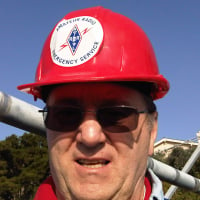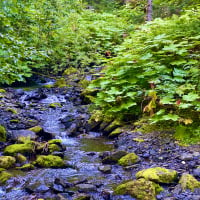SmartSDR v4.1.3 | SmartSDR v4.1.3 Release Notes
SmartSDR v3.10.15 | SmartSDR v3.10.15 Release Notes
The latest 4O3A Genius Product Software and Firmware
Need technical support from FlexRadio? It's as simple as Creating a HelpDesk ticket.
How to Build a Quiet Station
Comments
-
There are actually 3 different grounding systems to consider when setting up a station.
First is the Electrical Protection Ground (the 3rd or green wire in the AC Circuit). it is there to protect you in case there is a short from the hot wire to any surface.... this is NOT RF Ground...So you do not want to run your RF Ground to it....
Second is the Tower Protection Ground... this is a ground system near the tower to protect the tower in case of a lightning strike...Many people make the mistake of tying their tower to the re-bar in the concrete thinking it may be ground.. This is very dangerous as I have seen lightning strikes shatter concrete bases when they vaporize the re-bar. - The lightning protection ground needs to be mechanically connected to the tower to bleed off any lightning hits... it cannot be soldered as a lightning hit will melt the solder..... this is NOT RF Ground
The Third is the RF Ground which I detail in my "How to build a quiet station" presentation. Interestingly enough Ward Silver has an excellent article on RF Ground on Page 63 Jan 2015 QST which says exact what i said in my presentation..right down to copying my idea of using inexpensive 1/2" copper pipe as your RF Ground Bus.
Still Jet Lagged.. but I will answer your questions in detail shortly
0 -
Brent
Finally Over the jet Lag
First the lightning protection is there for Lightning Protection.
Not a good idea to cut into it and may be illegal to do so under building codes - please check with your local building codes. If they allow you to ground your tower for lightning protection to the lightning rod system you will need to make MECHANICAL connections as soldered connections will melt in a lightning strike.
The lightning rod gives a cone of Protection for everything below it. The cone is roughly a line 45 degrees from the top of the rod to the ground. It also means that you should not put up anything higher than the Lightning Rod Cone of Protection. If you do, then whatever is higher becomes the lightning rod.- Very Bad Idea - unless there is some way to bleed of the charge...
Second... as I said before your green wire is NOT RF Ground.. it's at least 100' above RF ground so it would only become another noise collecting antenna
Third... I have used that MFJ-931 with some success in Condo's as an Artificial RF Ground -- it does a decent job maximizing RF current to ground and can make a huge difference on received signals. However tuning can be very sharp ....
FYI - in the past, I have lived in 20 story Condo's.....surprisingly my best antenna system was a 20' long fishing pole stepped out from the balcony with a wire hanging vertically down 200'.... worked DXCC many times with that antenna albeit tuning it was a nightmare and I Worked All Neighbors with it..if it was not tuned correctly..
0 -
Howard, Thanks for the input.
Yes the lightning rod is up about 30' above the elevator tower, which is about 25'x25', and that is about 30' above the rest of the building. So that 60' stick is creating the cone of protection for the whole building, which as you say is about a 45 degree cone. All my antenna's will be below that protection. So I should never get the direct hit, but maybe some of the residual??
The huge copper cables, that this rod ties to, are exposed on the roof deck, and then go down the elevator shaft to a ground. It's been hit, with no issue several times.
My plan is to install my antenna (again below the protection), install a polyphaser lightening protection into my coax and ground to that same copper ground. I understand it would need to be mechanical.
So the question is should I also try and ground the radio and computers in the shack to the commercial ground (conduit and green wire) in the room?
With the lightning ground, and electrical ground, that leaves the RF ground. If I'm running dipoles or beams is that needed? Verticals certaintly need a RF ground, but I'm not sure I need it with dipoles/beams.
Glad your back among the "living" .
73 Brent NB4AP
0 -
For Clarification
I do NOT recommend bonding anything to the Lightning Protection System UNLESS it is allowed by local building codes.
As far as I know, most building codes do NOT allow you to bond anything to the lightning protection system UNLESS you are installing something above the Cone of Protection – in which case that structure becomes the lightning rod and needs to be mechanically secured to the other lightning protection systems.
BTW… there is virtually no lightning in La Jolla, CA.. last occurrence of even thunder was 20 years ago…
0 -
Please check with your local building code if they will allow you to connect the tower to the Lightning Protection System.
In theory the Antennas inside the Zone of Protection should be protected. In practice nothing is perfect, Lightning has a mind of its own and may just jump into that Zone
The Commercial Ground (Green Wire) is NOT RF Ground but only acts as AC protection in the event of a short to the AC system. According to Code, all non isolated AC devices need to be connected to the Commercial Ground
When I lived in a Condo I bonded all the chassis together and connected them to the MFJ-931 so that I could have a RF Ground to minimize RFI - PLUS lots and lots and lots of Ferrites...
0 -
SteppIR Controller.
Short Answer.. I put a Faraday Cage around the power supply and put lots of ferrites on the power input and power output
LONG ANSWER:
I bought SteppIR MonstIR Serial #1 10 years ago....My buddy Dennis N6KI bought MonstIR Serial #3... we quickly discovered that there were 2 major problems with the Power System.
First - the 33V Wall Wart Brick was incredibly noisy
Second - When tuning the Motors generated Hash (Cracklies)
Dennis and I spent considerable amount of time trying to solve both problems. If you want to read about our various attempts over during 2005 and 2006, we did document our efforts extensively on the SteppIR Yahoo Group.. Search Cracklies..
To solve #1 We tried ferrites on the power input and power output... some noise reduction but since it is a plastic case there was still significant noise... the real solution was to rebuild the power brick into a Metal Box (Faraday Cage) then connect the cage to the RF Ground bus. By using BOTH Ferrites and the Faraday Cage, we were able to quiet down the 33V brick sufficiently that it was no longer a significant problem
#2 - was a much more complicated issue... the cracklies only appeared when tuning the motors... we found that part of the cause was corrosion on the tapes.. fixed by replacing tapes - but not fixed enough to let us autotune during a contest... so we built a number of different filter boxes of ever increasing complexity.. again we documented this on the SteppIR Yahoo Group...we were able to reduce the Cracklies somewhat but never nearly enough to satisfy Dennis.. But then nothing is ever good enough for Dennis....
Then I stepped back to reconsider what we were doing and came to the conclusion that I could live with the Cracklies even in a contest...
Dennis' solution was to disable Autotune during contests..no cracklies.. the antenna works well all over the bands...
My solution was to live with the 1-3 seconds of cracklies when changing frequencies as I do not use a tuner anywhere in my system so I appreciate the added perfect SWR performance of the SteppIR
0 -
Detailed answer on the next page
0 -
Wow... Just installed 29 (of 30 purchased recently) little split beads all over my 6300 / 5000 based shack. I've only been listening for about two hours but it does seem to make a difference. I've always had a lot of 31 mix cores and split beads on power, speaker, mic and misc. other cables in and out of my Flex radios. Amazon has a nice assortment of split beads and holders at $5 for ten 5 mm and 7 mm ID sizes and $7.50 for ten 9 mm ID sizes. Placed these beads on CAT 5 cables (both ends), router power, every wall wart/monitor power supply (in and out where possible), amp keying and ALC lines, basically wherever possible.
Aside from lightning crashes and signals, 40 on the waterfall is a nice dark blue. 80 between roughly 3700 and 3850 has gone from green/orange to green/blue. Sorry, never wrote down before and after noise levels. This looks like the best $18 I've spent in a long time!
0 -
Bill I see these on Amazon, and I found the manufacturer in China, but I do not see any indication of what material specification these conform to. Do you know that they are type 31?0
-
The best place to start with ferrites is at the feed point of your antenna. I put about 16 inches worth of 31 mix ferrites at my feed point and didn't have to do anything in the shack. If you keep the RF out you don't need to spend a lot of time chasing cables that have turned into antennas.
Jon...kf2e
0 -
Hi Bill,
That is a very good price but like Alan I wonder if they are of the same quality and mix. The ones I buy from DX Engineering are much more expensive. ($3 to $6 each) but may be worth it. It would be interesting to know how they compare.
I used quite a few ferrites in my setup. The RFI and Grounding notes on my web page here:
http://www.nn4zz.com/FLEX6700.htm#RF_issues_and_solutions
Regards, Al / NN4ZZ
al (at) nn4zz (dot) com
0 -
Jon, I presume by the feed point you are referring the point where the feed line joins the antenna, where the balun would typically be. Are you using the 16 inches of 31 mix beads as your balun or in addition to it?0
-
Hi Jon,
Agree with your feed point comment as the starting point and like you said it may be the only place needed in some cases. There is another place to consider if you have several towers/antennas and many runs of coax coming to the shack. RF can be picked up on one of the antennas or coax from an antenna you aren't transmitting on. I've found that ferrites just outside the shack is another good spot. In my case I have an antenna switch (array solutions ratpack) outside the shack and only one coax cable coming in. This is a good place to add ferrites also.
You can never have too many ferrites -- the only downside is the cost.
Pictures here:
http://www.nn4zz.com/FLEX6700.htm#RF_issues_and_solutions
Regards, Al / NN4ZZ
al (at) nn4zz (dot) com
0 -
Al, have you compared the Ferrite Beads at Palomar Engineering? The specs look as good or better than DX Engineering and the price in general is much better (see their table). I haven't bought any yet but am looking for the most reasonable source.0
-
Alan,
Yes, at the feed point of the antenna and yes, it is in addition to the balun.
Here is the best deal I have found for 31 mix snap on cores.
http://www.mouser.com/ProductDetail/Fair-Rite/0431164181/?qs=%2fha2pyFadui9i7OfS7yC6UQqC3M9yLQhKcwDW...
If you go in with a buddy they are less than $3 each.
I used one piece cores and just removed the connector to install them. They are even less.
Jon...kf2e
0 -
My comment about them being 31 mix was based comments of other hams reviewing them on Amazon. I know some people complained about some of these Chinese beads being broken on arrival. All 30 of mine were intact. They have eliminated a detectable amount of noise around the shack.
BTW, I run "line isolators" on my HF feedllines which in and of themselves, have a lot of cores placed along about 12 inches of high temp coax.
0 -
Hi Alan,
I haven't used the Palomar ferrites. I've been dealing with DX Engineering for my TiltPlate business for about 10 years. They have been excellent to work with and the products are good quality so I generally use them by default. I expect other major vendors like Palomar, Fair-Rite or Mouser, etc are just as good.
Regards, Al / NN4ZZ
al (at) nn4zz (dot) com
0 -
A UK source for the type 31 cores to which Jon - KF2E refers is http://www.rapidonline.com/electronic-components/snap-on-ferrite-cores-68048 . That is not the only page on which they are listed IIRC. Many sites are very shy at listing the type of ferrite used.
0 -
Thanks for the article on Building a Quiet Station.
I'm just building up my station for soon to arrive 6300 and this document provides great direction and answers lots of my questions.1 -
Do the file links not work anymore?
73 Chris AK4SK
0 -
This part of the thread is two years old, so the question of tapping into the Commercial Lightning Rod system has probably been answered for the original questioner. But I would add for other's consideration that doing this without proper engineering support and legal authority could open someone up to serious legal liability. In our current litigious society, if someone suffered lightning or electrical damage (even if it had absolutely nothing to do with your tapping into the ground system) you might become the patsy for the attorneys to blame in order to recover damages. Juries are sometimes notorious for ignoring science and common sense and making massive financial judgments based upon pure emotion and courtroom theatrics. (Remember the "$5 Million McDonalds hot-coffee case?")
I have heard of hams who attached a simple TVI filter in their neighbor's feedline between the antenna and TV being sued when the TV stopped working. The "neighbor" claimed "It was working just fine until this CB-er put that thingy on my TV set...."1 -
Yes they do but you must have a dropbox account
0 -
Thanks. I have a Dropbox account so I'm good there. I asked because earlier the links weren't showing up. I could see partial links in the text but they were incomplete and there were no hyperlinks for some reason. I guess my browser was going something funny.
73 Chris AK4SK0 -
I read this about every 6 months as a refresher

Couple questions.
I have a copper bus in the shack and all my equipment attaches to it with 5/8" braid. The inside bus is connected to a copper bus outside with surge protectors using 1" braid for the RF and #6 stranded.
I have three 8' ground rods spaced 3' to 4' apart and all are interconnected with #6 wire. My outside copper ground bus is connected to those ground rods by two #6 wires. See pictures.
I am wondering if I would benefit from adding an additional 1" braided strap from the ground bus to a ground rod for a lower impedance path?
Rich

0 -
It depends on the length f the strap and whether it's ndoors or outdoors Braided strap is not good outdoors. As it is very susceptible to corrosion A short run will help. A long run of even 1/4 wave will hurt.0
-
It is outdoors.
I wonder if there is anything that you can use to protect braid outdoors as I have about 10" exposed. Thinking some spray on chemical to saturate the braid.
Come to think about it my BigIR is connected to my DX engineering radial plate via ground strap braid.
And my #6 wires to the ground rods is only about 4 ' long each.
Thanks Howard.
Rich0 -
Try CorrosionX http://www.corrosionx.com/corrosionx.html I use it a lot on my boat, I learned about it from my commercial fisherman friends and family here in Alaska. It works really well. If your braid is in a location where it gets a lot of wet weather you might have to reapply it every few months. They make a variety of products, and have a heavy duty version that is pretty thick and would probably last really well in exposed applications like that. I don't believe it has any effect on the electrical properties of the braid, but someone else might know better. I use it on electrical (12V) connections all the time with no ill effect. PS - I also regularly review Howard's "quiet shack guide". ;-) Justin KL2D0
-
I am hoping the fact my braid is tinned helps.
I will take a look at that link.
Rich
0 -
For my outside connections I use1/2"copper pipe instead of braid0
-
I saw that. How do you connect your copper pipe to a ground rod? Flatten it?
0
Leave a Comment
Categories
- All Categories
- 381 Community Topics
- 2.1K New Ideas
- 633 The Flea Market
- 8.3K Software
- 131 SmartSDR+
- 6.4K SmartSDR for Windows
- 185 SmartSDR for Maestro and M models
- 430 SmartSDR for Mac
- 272 SmartSDR for iOS
- 259 SmartSDR CAT
- 197 DAX
- 382 SmartSDR API
- 9.4K Radios and Accessories
- 41 Aurora
- 265 FLEX-8000 Signature Series
- 7.2K FLEX-6000 Signature Series
- 955 Maestro
- 56 FlexControl
- 866 FLEX Series (Legacy) Radios
- 929 Genius Products
- 464 Power Genius XL Amplifier
- 340 Tuner Genius XL
- 125 Antenna Genius
- 297 Shack Infrastructure
- 209 Networking
- 461 Remote Operation (SmartLink)
- 144 Contesting
- 788 Peripherals & Station Integration
- 140 Amateur Radio Interests
- 1K Third-Party Software





